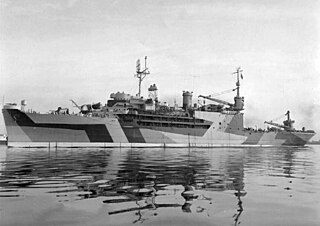
USS Greenwich Bay (AVP-41), was a United States Navy Barnegat-class small seaplane tender in commission from 1945 to 1966.

USS Suisun (AVP-53) was a United States Navy Barnegat-class small seaplane tender in commission from 1944 to 1955. It was named for northern California's Suisun Bay, which takes its name from the Native American Suisun tribe.

USS Duxbury Bay (AVP-38) was a United States Navy Barnegat-class small seaplane tender in commission from 1944 to 1966.

USS Currituck (AV-7) was the first of four Currituck class seaplane tenders, and was nicknamed the Wild Goose. She was built during World War II and served during the Cold War.

USS Hamlin (AV-15) was a Kenneth Whiting-class seaplane tender in the United States Navy.

USS Cumberland Sound (AV-17) was a Kenneth Whiting-class seaplane tender in the United States Navy.

USS Onslow (AVP-48) was a United States Navy Barnegat-class seaplane tender in commission from 1943 to 1947 and from 1951 to 1960.

The third USS Casco (AVP-12) was a United States Navy Barnegat-class small seaplane tender in commission from 1941 to 1947. She saw service in World War II. After her decommissioning, the U.S. Navy loaned her to the United States Coast Guard, in which she served as the cutter USCGC Casco (WAVP-370), later WHEC-370, from 1949 to 1969.

USS Yakutat (AVP-32) was a United States Navy Barnegat-class small seaplane tender in commission from 1944 to 1946. Yakutat tended seaplanes in combat areas in the Pacific during the latter stages of World War II. After the war, she was in commission in the United States Coast Guard from 1948 to 1971 as the Coast Guard cutter USCGC Yakutat (WAVP-380), later WHEC-380, seeing service in the Vietnam War during her Coast Guard career. Transferred to South Vietnam in 1971, she was commissioned into the Republic of Vietnam Navy as the frigate RVNS Trần Nhật Duật (HQ-03). When South Vietnam collapsed in 1975 at the end of the Vietnam War, she fled to the Philippines, where the Philippine Navy took custody of her and cannibalized her for spare parts until discarding her in 1982.

USS Shelikof (AVP-52) was a United States Navy Barnegat-class small seaplane tender in commission from 1944 to 1947 and from 1952 to 1954.

USS Bering Strait (AVP-34) was a United States Navy Barnegat-class small seaplane tender in commission from 1944 to 1946. She tended seaplanes during World War II in the Pacific in combat areas and earned three battle stars by war's end.

USS Coos Bay (AVP-25) was a United States Navy Barnegat-class small seaplane tender in commission from 1943 to 1946 that saw service during the latter half of World War II. After the war, she was in commission in the United States Coast Guard from 1949 to 1966 as the cutter USCGC Coos Bay (WAVP-376), later WHEC-376.

USS Corson (AVP-37) was a United States Navy Barnegat-class small seaplane tender in commission from 1944 to 1946 and from 1951 to 1956.

USS Oyster Bay (AGP-6), originally and later AVP-28, was a United States Navy motor torpedo boat tender in commission from 1943 to 1946. She saw service in World War II.

USS Half Moon (AVP-26) was a seaplane tender that in commission in the United States Navy from 1943 to 1946 that saw service in the latter half of World War II. After the war, she was in commission in the United States Coast Guard as the cutter USCGC Half Moon (WAVP-378), later WHEC-378, from 1948 to 1969, seeing service in the Vietnam War during her Coast Guard career.

The second USS Barataria (AVP-33) was a United States Navy Barnegat-class seaplane tender in commission from 1944 to 1946. She saw service in the later stages of World War II and was decommissioned postwar. She then was transferred to the United States Coast Guard and was in commission as the Coast Guard cutter USCGC Barataria (WAVP-381), later WHEC-381 from 1949 to 1969, serving in the Cuban Missile Crisis and the Vietnam War during her lengthy Coast Guard career.

USS Gardiners Bay (AVP-39) was a United States Navy seaplane tender in commission from 1945 to 1958 that saw service in the latter stages of World War II and in the Korean War. After her decommissioning, she was transferred to Norway, and she served in the Royal Norwegian Navy as the training ship HNoMS Haakon VII (A537) from 1958 to 1974.

The second USS Rehoboth (AVP-50/AGS-50) was in commission in the United States Navy as a seaplane tender from 1944 to 1947 and as an oceanographic survey ship from 1948 to 1970.

The Barnegat class was a large class of United States Navy small seaplane tenders (AVP) built during World War II. Thirty were completed as seaplane tenders, four as motor torpedo boat tenders, and one as a catapult training ship.

USS Timbalier (AVP-54) was a Barnegat-class seaplane tender of the United States Navy. She was commissioned shortly after the end of World War II, and served between 1946 and her decommissioning in 1954. She later saw commercial service as the Greek cruise ship MV Rodos.






















